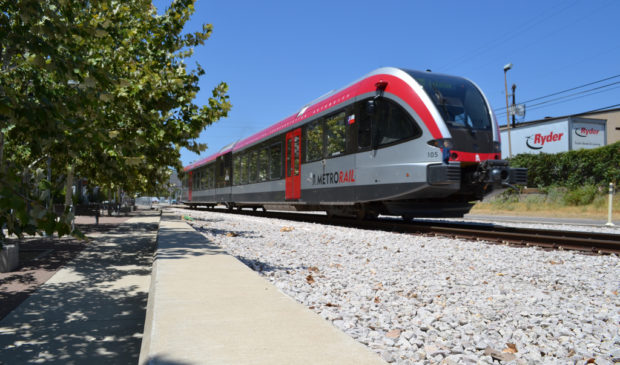Capital Metro’s budget grows as ridership shrinks
Thursday, September 22, 2016 by
Caleb Pritchard With the beginning of the next fiscal year just around the corner, Capital Metropolitan Transportation Authority staff are putting the finishing touches on the agency’s proposed $428 million budget.
On Monday, the board of directors will likely vote on the draft plan, which is more than $70 million larger than last year’s budget despite a continued drop in ridership.
While fare revenue is projected to be down half a million dollars, sales tax revenue is up by $14 million. The biggest driver of the drastic change from Fiscal Year 2015-2016 is $38 million in capital funding that is being carried over from that budget.
The extra cash on hand this year will afford $248.3 million in operating expenses, a $12 million increase compared to last year. However, that comes as the FY 2016-17 draft budget forecasts 2 million fewer riders than were predicted in 2016.
The draft budget notes that ridership declines on MetroBus, MetroRapid, ExpressBus and UT shuttle lines can be explained by a “shift of population outside of service area and increased UT housing capacity closer to campus.” Seemingly in response to that, the services that would see the largest increase in vehicle miles and hours of service are the paratransit MetroAccess and those that target suburban areas: MetroRail, ExpressBus and the Capital Area Regional Transportation System.
Each of those services comes with a higher-per-rider cost than MetroBus, which is forecast to have served 71 percent of Capital Metro’s $30.4 million riders in FY 2015-16.
The draft budget reports that the per-rider subsidy on MetroBus is increasing by approximately 50 cents in FY 2016-17 to roughly $6. Meanwhile, a ride on MetroRail costs the agency over $30 per passenger, a slight increase compared to the current fiscal year.
The agency has previously blamed its sagging ridership on inclement weather, namely the record rains that have fallen on Central Texas in recent months. Despite that, the FY 2016-17 draft budget includes only $150,000 for new shelters at bus stops.
“While bus stop amenities are important to our customers, access to our bus stops has been an even bigger need,” agency spokeswoman Mariette Hummel told the Austin Monitor. “Over the last six years, Capital Metro has been working to improve accessibility at all bus stops in the system.”
Hummel said that since the effort’s inception, the agency has completed 1,500 of its identified projects, which range from bus stops to sidewalks and curb ramps. She explained that the agency expects to nearly complete the bus stop accessibility program by the end of next year. To that end, the draft budget earmarks $300,000 for those projects.
It also includes $4,143,000 for new or expanded park-and-ride facilities outside of the central city and $5,652,000 – courtesy of Texas Department of Transportation grants – for the upgrades planned for MetroRail’s downtown station.
The projected decline in fare revenue – from $25.58 million in FY 2015-16 to a projected $25.07 million in FY 2016-17 – does not account for the expected fare leveling that will occur during the implementation of Connections 2025, the agency’s long-range plan that will be approved by the board of directors this fall. The draft of that plan calls for reducing the $1.75 premium fare on MetroRapid lines to the same level as the $1.25 fare for MetroBus service.
The budget indicates that the earliest that change could be implemented is January 2018. However, Hummel hinted that riders may not have to wait that long.
“The specific timing of the various recommendations contained in Connections 2025, including those related to fare reform, has yet to be determined,” she said. “Capital Metro is working with the consultant team to assess the requirements and potential impacts of the changes in order to develop a phasing plan. The objective is to implement these changes as quickly as feasible.”
If the board approves the draft budget on Monday, it would take effect on Oct. 1.
Photo by Steven Polunsky made available through a Creative Commons license.
The Austin Monitor’s work is made possible by donations from the community. Though our reporting covers donors from time to time, we are careful to keep business and editorial efforts separate while maintaining transparency. A complete list of donors is available here, and our code of ethics is explained here.
You're a community leader
And we’re honored you look to us for serious, in-depth news. You know a strong community needs local and dedicated watchdog reporting. We’re here for you and that won’t change. Now will you take the powerful next step and support our nonprofit news organization?







